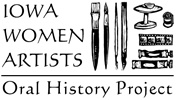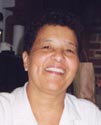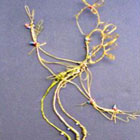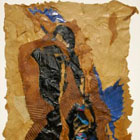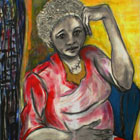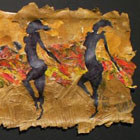JEAN BERRY
artwork | audio clips (text only) | statement | 2008 update | galleries
artwork
artist statement
More than anything I want my art to evoke some kind of response: positive or negative from the people who view it. My subject has been people and I feel it always will be people because people are interesting to me. They are different in as many ways as they are alike. My work, be it representative or abstract images, explores differences. It represents the important moments in our lives and the lives around us.
My wish is when viewing my work one becomes a part of it. Let it take you to that place, spark a memory, create a sense of touch, express an emotion. Emotion is the key to my work...pain, love, happiness, innocence, joy, peace, hope, loss, sacrifice, danger and so much more.
2008 update
How has your life changed since the interview?
There has been a broader acceptance of my work and of me as an artist. I am now internationally known. Having my work in other countries has brought me an inner joy. I have work in the Gencor-Gallery at the Rand Afrikanns University in Johannesburg, South Africa. The series is called Blood on the Field and was first exhibited at the Des Moines Art Center in the Iowa Artist Show in 1998. I have work in private collections in Paris, Kingston Jamaica and Belize City (Central America). My work is also in national museums such as African American Historical Museum and Cultural Center of Iowa in Cedar Rapids, Iowa and the Waterloo Art Museum in Waterloo, Iowa. My papers and an original piece called Mary Louise are located at The University of Iowa Women Archives. The change that has most affected me is my move to Iowa City/Coralville area. I have had to move to a smaller studio space. I am not well organized yet, so it is kind of hard to find anything. The space has made me rethink my approach to creativity. In time I know I will adjust and I feel blessed to be here. I look forward to getting to know the Iowa City artistic community.
What kind of artwork are you doing now?
My current work using recycled materials would be considered "Green Art". Found objects like metal, plastic and natural artifacts are combined with torn pieces of corrugated cardboard, or colored paper and charcoal figures made of oil bar and pastels. Some of these pieces are representational and some are more abstract. I am using a little more color to highlight the movements of dance; leaps, bends, dips, jumps, stands and squats surrounded by a powerful cardboard canvas. I have worked with the figure in a variety of other ways as well. For example cloth dolls, copper wire figures with found objects, and metal sculpture were my focus for a while — and my base has always been charcoal drawings.
How has your artwork changed in the last ten years?
The work I exhibited in 2007 at the Iowa Arts Festival was more abstract than anything I've done. This came about from my problems with earlier work. Irritated because my work wasn't doing what I thought it should do, I began to tear up pieces (I've always torn up my work when I did not like it). One day a friend, Madai an artist from Fort Dodge, encouraged me to take the pieces out of the trash and work with them. I did and as I reshaped and reformed the images they became powerful. I had found a new style that was very motivating.
What motivates you to continue making art?
My love for art and the blessing that it is to me. What God has given you — if you do not use it — you can lose it. I do not intend to lose my gift. My inspiration comes from almost anywhere at anytime. Like novels.
I did a series depicting characters in a self-published novel, The Saint's of Kemet (Egypt). Now, it's my son's unpublished novel, the Honey Man's Son, that I'm working on. Plus I am still developing an on going series of Miss Averi (my granddaughter).
There is a spiritual connection/movement in all of my work and my experience, very intense, in the motherland (Africa) was the link I had been searching for. It was late afternoon and flying into Johannesburg I looked down on the landscape, the terrain, the land and saw the power of my art; the reds, the blacks and even the torn corrugated cardboard from Blood on the Field. Not just me, but my art was coming home.
What advice do you have to give to others?
Be true to yourself. I do believe that Art is God's gift. It is away of letting the little guys (like myself) express what this world is all about! It's from our point of view. Sometimes it is pretty and sometimes it's not — but that's how life is.
audio text
Parents
My dad was a Pullman porter, which in those days was a good job for a black man to have. But he was a musician on the side, so most of his money went into his music. And when I was smaller, I'd stay with a babysitter when he was gone on the road, but then when he would come home, then I would be with him. He was a jazz musician, and they'd be practicing—he would take me with him.
When I was seven years old, Billie Holiday came to this bar where my dad practiced at, and I was sitting there. So she came over in this booth; she set with me the whole three or four hours that they were there, and she'd talk with me, play with me, and that kind of stuff.
My mom was a very strong-willed person. She and my dad divorced when I was nine years old, so she had to take care of my brother and my sister and I. So she worked a full-time job. She was very strong and very motivating. She pushed us all to graduate from high school, because in those years, that was it—that was to get a good job.
We were poor, but we were happy. And you knew you were poor. I mean, we had enough to eat, we had clothes and we had shelter—the basic things. But we didn't have any of the real luxuries.
Early art
I couldn't stand to see a clean sheet of paper. I mean, I'd draw on anything—anything that had a clear surface; it was like my canvas to create. We lived in a white, cinder brick house in this little complex area. All the houses looked the same; they were duplexes, and they were all painted white. For some reason, one day I got it in my head that this was my canvas, and I should create here. I decided that our house would stand out from the other houses; I wanted ours to be different. So I said I would put a border around our house. I went around the whole thing—both duplexes, though. And the center of it, I drew and painted with my crayons. Of course, when my mom got home that evening from work, it wasn't acceptable. I got a little spanking, and then she gave me some Ajax and she gave me a sponge and a bucket of water, and I had to go around that house, and I had to wash all of it off. Took me about three days to do it, but I finally got it done.
Women & art
I didn't graduate from high school. I married early and raised a family. I always was drawing something, I was painting something. I was giving stuff away.
I had a daughter to die at nineteen of cancer. I was really, really out of it for awhile. So I decided to go back to school. I took art ed. (Laughs) I've never liked kids. I did the practicum, and that was four months, and I knew then I couldn't handle it. Then I decided I was going to go back and get a master's. I was talking with a friend, and that's when things start picking up and taking off for me. Different people asking me to do exhibits and I was working on my artwork like 24-7. I mean, I was in my studio just constantly cranking stuff out. I had a friend tell me, "Well, maybe a master's is not for you. Maybe you should just go on and work at this time." And that's what I did. I just started working, and been working ever since.
I think by women going out and doing, and coming out of the home, made me want to come out of the home. I envied a lot of the women who went out before me, like ten, twenty years before. I think I compensated for that by saying that I was working for my husband as bookkeeper, secretary, and all that other stuff. So I kind of rationalized, Okay, I'm doing it, too. I'm independent. But I really wasn't. I feel that I'm a stronger and better person now through my relationship with strong feminist women—some of the women that I've met over the last ten years. I've changed.
My artwork
Now I'm in the charcoal with the collage, and I'm using corrugated cardboard and paper of any kind that I can find. I was doing charcoal on fine grade of rag paper. I think I'm going to always have some component of the charcoal drawing in whatever I do. I want to do that. Now the only bad thing about what I'm doing now, it doesn't have longevity. It's up to the curator to save it, not me. My job is to put it down.
It will probably be around for another twenty-five, thirty years—maybe forty, fifty years. But for a hundred years, no, it won't be around. But that's what they have these wonderful photographers for, just to take pictures of these things and keep record of it. Because I can't see art museums being able to exhibit all of the art that people are creating, from the past and what we have present day, and then the future. I mean, can you imagine how large your museums would have to be to accommodate all of that?
When I have it in here [points to head], then I have to get it out. And I have to get it out the way that I see is best to get it out. If it's going to last, it's going to last. If it's not, it's not. That's the only thing I can do.
Process
It starts out with an idea. I collect photographs and stuff out of magazines, newspapers, whatever, and I compile them all together like maybe the lady's head wrap on one and [hands of another]. Or maybe there's a facial expression in the newspaper that I like. Maybe it's a garment in a magazine or something. But I combine all these things, I compile all these things, and I go through and I'll look and I'll say, Oh, this will work with this, and this will work with this. So then I put them all on kind of like a storyboard, and I put that in front of me, and then I work from that. Just something hits me, and then all of a sudden I start working, and then I work like mad.
And it is kind of like a non-stop. I don't stop to eat, and I become angry if I'm disturbed. I work three, four, five o'clock in the morning. And I'll come down, take a shower, get my pajamas on, and I'll get in bed, and I'll be lying there, and something will come to me, and I'm back upstairs again. I think I work until I'm exhausted. Then I just fall out, sleep, and then get up and go back to it. Because it's like it's an ongoing thing that you can't quit. You can't set it to the side and then come back to it. That's not possible for me. Now maybe some people can do that, but I can't.
And when I put my artwork out there, I'm sharing a part of me with the world. It lifts me to a higher plain. And it's like, you're in touch with different things—something that's out beyond what's here in the realm of reality.
Advice
Go for it. Stick to it, even if you have to get yourself a little part-time job, keep body and soul together. But don't give up on your artwork, because you can make it. You can. I visited with Betye Saar when she was here. She said that art has really kept her together—through her bad times and her good times, that she always knew that she had her art. And actually, I feel the same way. When I think about it, I always had the art. It was always there, even as a small child, it was there. As a teenager, it was there. When I was a young woman raising my kids, it was there. Now that I'm mature, it's there. And it's more predominant with me now, than ever before.
